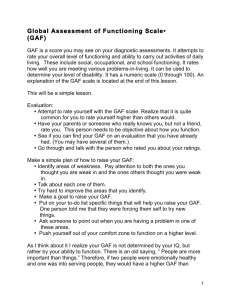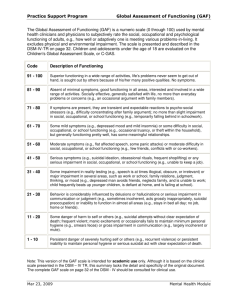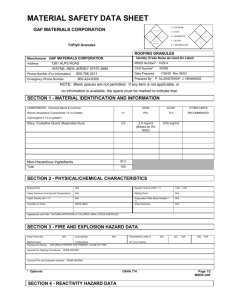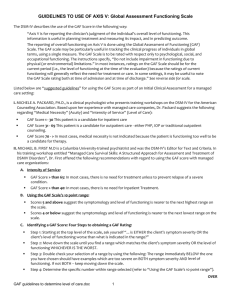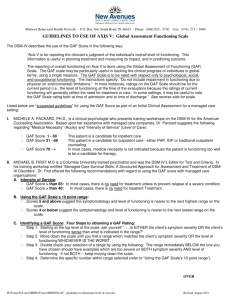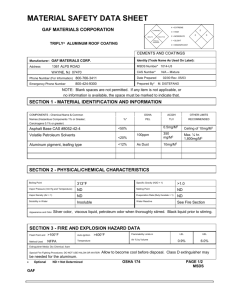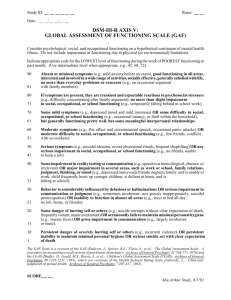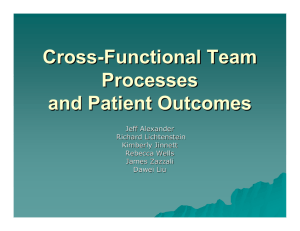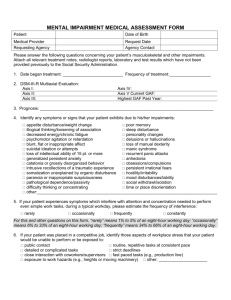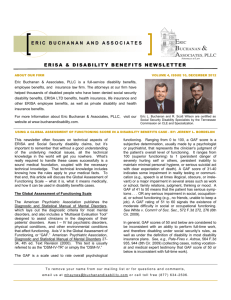Gaf: What Every Litigator Needs To Know
advertisement
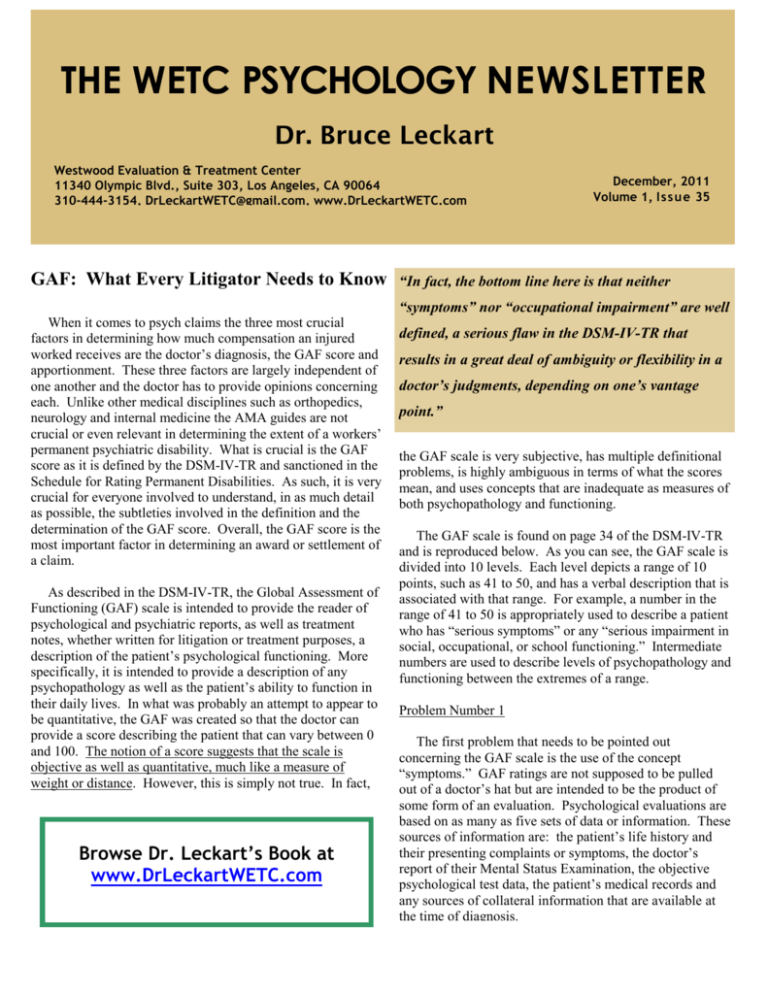
THE WETC PSYCHOLOGY NEWSLETTER Dr. Bruce Leckart Westwood Evaluation & Treatment Center 11340 Olympic Blvd., Suite 303, Los Angeles, CA 90064 310-444-3154, DrLeckartWETC@gmail.com, www.DrLeckartWETC.com December, 2011 Volume 1, Is s ue 35 GAF: What Every Litigator Needs to Know “In fact, the bottom line here is that neither “symptoms” nor “occupational impairment” are well When it comes to psych claims the three most crucial factors in determining how much compensation an injured worked receives are the doctor’s diagnosis, the GAF score and apportionment. These three factors are largely independent of one another and the doctor has to provide opinions concerning each. Unlike other medical disciplines such as orthopedics, neurology and internal medicine the AMA guides are not crucial or even relevant in determining the extent of a workers’ permanent psychiatric disability. What is crucial is the GAF score as it is defined by the DSM-IV-TR and sanctioned in the Schedule for Rating Permanent Disabilities. As such, it is very crucial for everyone involved to understand, in as much detail as possible, the subtleties involved in the definition and the determination of the GAF score. Overall, the GAF score is the most important factor in determining an award or settlement of a claim. As described in the DSM-IV-TR, the Global Assessment of Functioning (GAF) scale is intended to provide the reader of psychological and psychiatric reports, as well as treatment notes, whether written for litigation or treatment purposes, a description of the patient’s psychological functioning. More specifically, it is intended to provide a description of any psychopathology as well as the patient’s ability to function in their daily lives. In what was probably an attempt to appear to be quantitative, the GAF was created so that the doctor can provide a score describing the patient that can vary between 0 and 100. The notion of a score suggests that the scale is objective as well as quantitative, much like a measure of weight or distance. However, this is simply not true. In fact, Browse Dr. Leckart’s Book at www.DrLeckartWETC.com defined, a serious flaw in the DSM-IV-TR that results in a great deal of ambiguity or flexibility in a doctor’s judgments, depending on one’s vantage point.” the GAF scale is very subjective, has multiple definitional problems, is highly ambiguous in terms of what the scores mean, and uses concepts that are inadequate as measures of both psychopathology and functioning. The GAF scale is found on page 34 of the DSM-IV-TR and is reproduced below. As you can see, the GAF scale is divided into 10 levels. Each level depicts a range of 10 points, such as 41 to 50, and has a verbal description that is associated with that range. For example, a number in the range of 41 to 50 is appropriately used to describe a patient who has “serious symptoms” or any “serious impairment in social, occupational, or school functioning.” Intermediate numbers are used to describe levels of psychopathology and functioning between the extremes of a range. Problem Number 1 The first problem that needs to be pointed out concerning the GAF scale is the use of the concept “symptoms.” GAF ratings are not supposed to be pulled out of a doctor’s hat but are intended to be the product of some form of an evaluation. Psychological evaluations are based on as many as five sets of data or information. These sources of information are: the patient’s life history and their presenting complaints or symptoms, the doctor’s report of their Mental Status Examination, the objective psychological test data, the patient’s medical records and any sources of collateral information that are available at the time of diagnosis. Page 2 Most importantly, it is essential to understand the definition of the word “symptoms.” As the above paragraph indicates, the word “symptoms” is synonymous with the word “complaints.” Specifically, as defined by the Oxford Dictionary of Psychology a symptom is, “A subjective indication of a disorder reported by an afflicted person rather than being observed by an examiner” (Coleman, Andrew, M. Oxford Dictionary of Psychology, New York: Oxford University Press, Incorporated, 2001). However, and most importantly, a person’s symptoms are obviously only a small portion of the data the doctor uses in arriving at a diagnosis and a GAF score. Clearly, the doctor must use their own observations, or what are called “signs,” specifically those made during their Mental Status Examination, but also those made during the remainder of the face-to-face clinical interview. Obviously, the doctor also must use the psychological testing data and any credible information found in the patient’s medical and employment records. So at the risk of appearing a bit presumptuous or arrogant I would have to say that the DSM-IV-TR is quite wrong in stating that a patient’s GAF score is determined by their “symptoms.” At the very least, data from the doctor’s observations or the “signs” presented by the patient must also be used in arriving at the GAF score. The use of the word “symptoms” in the GAF definition has led to some interesting situations. I recently had the opportunity to review a psychiatrist’s deposition testimony in conjunction with a pre-deposition consultation and was not really surprised to find that the psychiatrist defended their GAF score by stating that it was entirely consistent with, and solely the product of, the patient’s symptoms or complaints. Only when the attorney asked if the GAF score was also consistent with the remainder of the data did the doctor admit that it was not, although they added that they came up with the GAF score by following the “letter of the law” and used the patient’s symptoms or what they complained about. FREE pre-deposition consults involving reports of a QME PQME AME AQME (e-mail us at DrLeckartWETC@gmail.com for more information) Problem Number 2 The second major problem with the GAF scale is that the terms used to arrive at the GAF scores are not defined. In almost all workers’ compensation and personal injury cases the final GAF scores range from about 31 to 90. In all but the lowest GAF category, the DSM-IV-TR defines psychopathology with the terms “minimal symptoms,” “transient and expectable” symptoms, “mild symptoms,” “moderate symptoms,” and “serious symptoms.” However, those terms are never clearly defined. Instead of definitions, what the DSM-IV-TR authors provide are examples of each. Thus, in discussing a GAF range of 61 to 70 they state that the range is characterized by “mild symptoms,” such as a “depressed mood and mild insomnia.” Unfortunately, a depressed mood and mild insomnia can occur in a wide variety of psychological disorders that have greatly different severities. As such, knowing that a patient has both of those signs and symptoms is of little help in determining their GAF. Moreover, since a “depressed mood and mild insomnia” is just an example, there is no indication as to what other types of signs and symptoms would fit into the range of 61 to 70. Clearly, this ambiguity provides an inadequate guideline for the doctor who has a great deal of latitude in determining a GAF for a given patient, almost regardless of their psychological signs, symptoms, psychological testing data and records. In fact, this latitude opens the door to a far-reaching level of subjectivity, which is not at all what one would expect from the face value numerical definition of the GAF! Problem Number 3 The subjectivity issue is not limited to the patient’s symptoms, signs, testing and records. As you can see from the GAF scale presented below, there are two ways a doctor can arrive at a GAF score. As discussed above, the doctor can come up with the GAF score by looking at the symptoms, signs, testing and records. However, the DSM-IV-TR is very specific in stating that the doctor can use the patient’s symptoms “OR” the individual’s difficulty or impairment in “social, occupational or school functioning.” Moreover, the DSM-IV-TR states on pages 32 and 33 that, “It should be noted that in situations where the individual’s symptom severity and level of functioning are discordant, the final GAF rating always reflects the worse of the two.” Thus, according to DSM-IV-TR standards, the doctor uses the lowest of the two scores in determining the final GAF. Page 3 Unfortunately, while having the option of using the individual’s level of psychopathology or their level of functioning seems to be a good idea for rating disability, as was the case with “symptoms,” the concept of “social, occupational or school functioning” is not defined in any clear or objective manner, but by examples. Thus, a “serious impairment in social, occupational, or school functioning” is said to be present when the patient is “unable to keep a job.” However, it should be relatively obvious that “unable to keep a job” is wildly ambiguous since no information is provided about the nature of the job that one supposedly cannot keep. For example, consider the case of a physicist at a local university who is unable to work at his normal full professorship but can dig ditches. Is it reasonable to conclude that he could keep a job? And if so, would you be willing to conclude that he has a “serious impairment in occupational functioning” or would it be more reasonable to conclude that he has a “major impairment” or even a “moderate impairment?” Clearly, the DSM-IV-TR is silent on the issue of which occupation the impairment is to be rated on. Is this the open labor market or the individual’s normal and customary work? Or, are we talking about the ability to do any job? Issues like the above abound at all levels of the GAF scale. For example, is it really reasonable to conclude that an individual qualifies as having a “moderate difficulty” in occupational functioning, with a concomitant GAF score of perhaps as low as 51 if they have “conflict with peers or co-workers?” Overall, the DSM-IV-TR definition of the GAF scale is full of ambiguity and one should not be mislead by the “pretty face” of a numerical scale that, on the surface, appears to quantify disability. In fact, the bottom line here is that neither “symptoms” nor “occupational impairment” are well defined, a serious flaw in the DSM-IV-TR that results in a great deal of ambiguity or flexibility in a doctor’s judgments, depending on one’s vantage point. Thus, when a physician summarily provides a GAF score without providing some fairly specific information about a patient’s symptoms or complaints, their observable signs, the psychological testing, and the medical and employment records that justifies their conclusions they are on very thin ice. This is the thirty-fifth of a series of monthly newsletters aimed at providing information about psychological evaluations and treatment that may be of interest to attorneys and insurance adjusters working in the areas of workers’ compensation and personal injury. If you have not received some or all of our past newsletters listed on the next page, and would like copies, send us an email requesting the newsletter(s) that you would like forwarded to you. Page 4 Global Assessment of Functioning (GAF) Scale from page 34 of the DSM-IV-TR According to the DSM-IV-TR, a GAF range of 91 to 100 is defined as: Superior functioning in a wide range of activities, life’s problems never seem to get out of hand, is sought out by others because of his or her many positive qualities. No symptoms. A GAF range of 81 to of 90 is defined as: Absent or minimal symptoms (e.g., mild anxiety before an exam), good functioning in all areas, interested and involved in a wide range of activities, socially effective, generally satisfied with life, no more than everyday problems or concerns (e.g., an occasional argument with family members). A GAF range of 71 to 80 is defined as: If symptoms are present, they are transient and expectable reactions to psychosocial stressors (e.g., difficulty concentrating after family argument), no more than slight impairment in social, occupational, or school function (e.g., temporarily falling behind in school work). A GAF range of 41 to 50 is defined as: Serious symptoms (e.g., suicidal ideation, severe obsessional rituals, frequent shoplifting) OR any serious impairment in social, occupational, or school functioning (e.g., no friends, unable to keep a job). A GAF range of 31 to 40 is defined as: Some impairment in reality testing or communication (e.g., speech is at times illogical, obscure, or irrelevant) OR major impairment in several areas, such as work or school, family relations, judgment, thinking, or mood (e.g., depressed man avoids friends, neglects family, and is unable to work; child frequently beats up younger children, is defiant at home, and is failing at school). A GAF range of 21 to 30 is defined as: Behavior is considerably influenced by delusions or hallucinations OR serious impairment in communication or judgment (e.g., sometimes incoherent, acts grossly inappropriately, suicidal preoccupation) OR inability to function in almost all areas (e.g., stays in bed all day; no job, home, or friends). A GAF range of 11 to 20 is defined as: A GAF range of 61 to 70 is defined as: Some mild symptoms (e.g., depressed mood and mild insomnia) OR some difficulty in social, occupational, or school functioning (e.g., occasional truancy, or theft within the household), but generally functioning pretty well, has some meaningful interpersonal relationships. A GAF range of 51 to 60 is defined as: Moderate symptoms (e.g., flat affect and circumstantial speech, occasional panics attacks) OR moderate difficulty in social, occupational, or school functioning (e.g., few friends, conflicts with peers or co-workers). Some danger of hurting self or others (e.g., suicide attempts without clear expectation of death; frequently violent; manic excitement) OR occasionally fails to maintain minimal personal hygiene (e.g., smears feces) OR gross impairment in communication (e.g., largely incoherent or mute). A GAF range of 1 to 10 is defined as: Persistent danger of severely hurting self or others (e.g., recurrent violence) OR persistent inability to maintain minimal personal hygiene OR serious suicidal act with clear expectation of death. A GAF of 0 is defined as: Inadequate information. Page 5 February, 2009 – Litigation Problems With The GAF July, 2010 - Bipolar Disorders March, 2009 – Common Flaws In Psych Reports August, 2010 - Mental Status Examination April, 2009 – The Minnesota Multiphasic Personality Inventory (MMPI) September, 2010 - Symptoms, Signs and the GAF: A Potential Litigation Problem May, 2009 – Apportioning Psychiatric Disability In Workers’ Compensation cases And Assessing Aggravation In Personal Injury Cases October, 2010 - What vs. Why: Determining Causality in Psych Cases November, 2010 - Tightrope Walking and the GAF June, 2009 - Subjectively Interpreted Projective Psychological Tests December, 2010 - Apportioning Psychiatric Injuries: A More Complete View July, 2009 - Sleep Disorders And Psychiatric Injuries January, 2011 - Personality Disorders August, 2009 - Posttraumatic Stress Disorder September, 2009 - Compulsive Computer Use Disorder February, 2011 - Apportioning Psychiatric Disability With Multiple Orthopedic Injuries October, 2009 - Major Depressive Disorder March, 2011 - How To Cx a Shrink November, 2009 - The Millon Tests April, 2011 - The Mental Status Examination - Revisited December, 2009 - Psychological Factors Affecting Medical Condition May, 2011 - Dysthymic Disorder June, 2011 - The Credibility of Psychological Diagnoses January, 2010 - Pain Disorders February, 2010 - Common flaws in psych reports #2 July, 2011 – Physical and Psychiatric Injuries: A Tale of Three Patients March, 2010 - Drugs: Use, Abuse and Dependence August, 2011 – Panic Attacks and Panic Disorders April, 2010 - Common Flaws In Psych Reports #3 September, 2011 – Psychological Treatment Records May, 2010 - "Impossible" MMPI-2 scores and their consequences for litigation October, 2011 – Anger: An Overlooked Injury June, 2010 - Adjustment Disorders November, 2011 – Neuropsychology and Psychiatric Injuries
